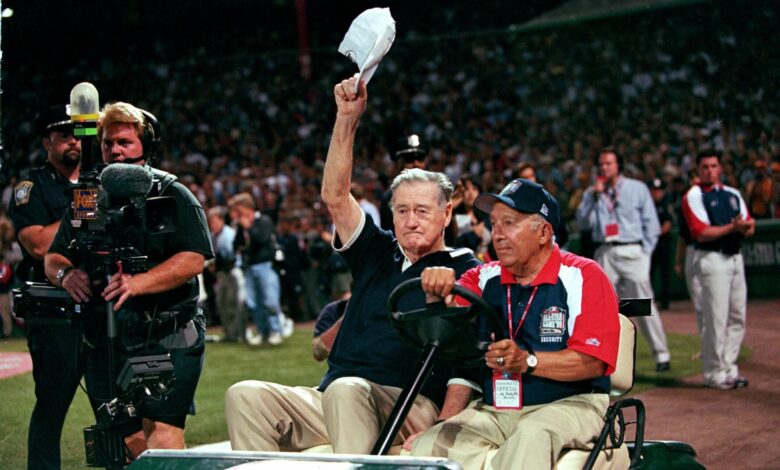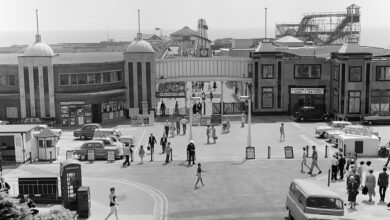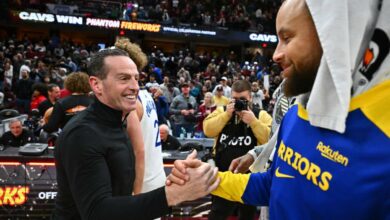25 years ago, Ted Williams created an All-Star moment for the ages

As he walked into the Four Seasons, Matt Damon did not know what to expect. The actor had just received a phone call asking if he wanted to meet Ted Williams. Damon did not need to think twice. “Absolutely,” he said.
Both were in Boston for the same reason. The 1999 Major League All-Star Game was set to unfold at historic Fenway Park on July 13. In addition to the normal festivities, 31 of the greatest living ballplayers would be introduced as part of an “All-Century Team” promotion to recognize the best players of the 20th century. After the legends walked in from center field, Williams would throw out the first pitch in what would become a unique moment in the sport’s history.
Damon, then 28, had already lived out a childhood dream. To prepare for the All-Star Celebrity Challenge, he had been able to take batting practice around midnight with his dad and others at Fenway. He had grown up attending Red Sox games, paying scalpers a few bucks for bleacher seats. Suddenly, he was taking cuts in the same park that Yaz and Pudge once called home.
“We literally said as we were coming home in this van at 1 a.m., maybe we should just go to the top of the Prudential building and jump. It’s never going to get better than this,” Damon told The Athletic. “We couldn’t believe they let us on the field. They were painting the lines as we were playing.”
Now he was about to meet Williams.
Damon was told the Hall of Famer had just finished a television interview. Approaching 81, Williams was not in great health. But Damon instantly noticed that the “Splendid Splinter” still had the booming voice. Still had a commanding presence. He introduced himself and told Williams that he had grown up in Boston. And that he had read his book as a kid.
“Bull—-! You didn’t read my book,” Williams said.
“I really did,” Damon said. “‘The Science of Hitting.’ I read your book.”
“All right, what do I say is the most important thing?”
“Get a good pitch to hit,” he said.
Williams jumped up and hugged the young actor.
Leading up to the event’s 25th anniversary, The Athletic talked with nearly 30 players, broadcasters and baseball officials who were at Fenway that July evening. Few remembered the final score — it was an All-Star game, after all — but nearly everyone remembered with great fondness the pregame ceremony, which involved perhaps the greatest collection of baseball talent ever assembled.

Noted Massachusetts native Matt Damon watches the action from the stands during the game. (Ezra O. Shaw / Allsport)
Pregame activities are scripted. Everything runs on schedule. Yet the 1999 All-Star Game is remembered for its spontaneity, and not for reasons you might think.
To start, no one knew for sure what to expect from Williams, ornery as ever in his later years.
Then-Boston general manager Dan Duquette had first invited the Red Sox legend and his son John Henry months earlier, a telephone conversation Duquette said unfolded like this:
Duquette: “Ted, we got the All-Star Game here in July and we’d love to have you here to throw out the first pitch.”
Williams: “I don’t know. I don’t know if I’m up for it. I haven’t been up there in a long time.”
Duquette: “Ted, you know you were the MVP of the last All-Star Game here in Boston.”
Williams: “God—- right I was. Let me talk to John Henry and call me back in a week.”
This went on for a month.
Former St. Louis Cardinals slugger Mark McGwire says the pregame ceremony was one of the greatest experiences he’s had on a baseball field, something he doubts could be duplicated. “It takes a lot to get me in awe of things. I think that was one of the first times I was in awe,” McGwire said.
Former Boston pitcher Pedro Martinez, who would capture game MVP honors after a dominating All-Star performance, says he could tell while warming up in the bullpen that the night would be special. The buzz was unmistakable. “There’s never going to be an All-Star game like that one,” Martinez said.
Former Colorado outfielder Larry Walker was so moved he took home a patch of Fenway turf he had kicked up during his time in right field. Walker slipped the grass into a baggy and placed it in a home refrigerator, adding water to help keep it alive, a science experiment that ultimately failed.
“I’m just a jock. I don’t keep grass alive for a living so I wasn’t sure what I was supposed to do with it,” Walker said. “It just seemed like a cool thing to do in the moment.”
The All-Century team walked out from behind a red curtain in “Field of Dreams” style. Actor Kevin Costner, a huge baseball fan, announced the accomplishments of each member, a group that included Henry Aaron, Willie Mays and Stan Musial, baseball royalty.
The National and American League All-Star teams were next, lining up on the baselines. Donna Summer sang the National Anthem. Then came the main event.
Williams appeared from behind the red curtain riding next to longtime Red Sox employee Al Forester in a golf cart. Public address announcer Ed Brickley handled the introduction.
“He wore the Red Sox uniform for 22 years. He wore the uniform of the United States Marines for four and a half more. …
“He was the last man to hit .400 in a season, and he did it 58 years ago. He hit 521 home runs, including one on his last at-bat. Ladies and gentlemen, please welcome the greatest hitter that ever lived, No. 9, Hall of Famer, baseball legend …”
Williams removed his hat and raised it with his right hand, acknowledging the crowd, something he famously avoided as a player because of his rocky relationship with Boston fans.
Standing beside his teammates, Philadelphia pitcher Paul Byrd thought about the time he had met Williams eight years earlier. In 1991, President George H. W. Bush invited the LSU baseball team to the White House to celebrate the Tigers’ national championship. As it turned out, Williams and Joe DiMaggio were also there for the 50th anniversary of the 1941 season, the year Williams hit .406 and DiMaggio hit in 56 consecutive games.
For Byrd, meeting Williams was like meeting John Wayne.
“There are certain moments you don’t forget,” Byrd said. “The first time your wife tells you she’s pregnant. When you get that call to the big leagues. Where you were when 9/11 happened. Some are good, some are bad. But when you meet Ted Williams for the first time and shake his hand, you don’t forget that moment.”
As Williams rode to the infield, Mets catcher Mike Piazza thought about the day the Boston icon had visited his home with a scout who was a friend of his father’s and watched a teenage Piazza hit in his backyard batting cage. Impressed, Williams told Piazza he attacked the ball better than he did at that age. It gave Piazza confidence that he had a future in baseball.
Fred Lynn watched from the “600 Club,” a VIP area located behind home plate. The former Boston Red Sox star had first met Williams after a home game during his rookie season. In 1975, Lynn was in the midst of an MVP season, and Williams wanted to check him out. They were similar, both left-handed hitters. Lynn positioned his hands differently but their swings had similar arcs. Williams asked Lynn for his theory on hitting. “I see it, I hit it,” Lynn answered.
He could tell Williams was not impressed.
In the 600 Club, Lynn watched Williams and the cart stop near the pitcher’s mound. For the past two days, he had participated in All-Star events. Lynn knew how big this night was for Boston. He wondered how the moment was translating onto television.
For years, it’s been said that the All-Stars decided on their own to surround Williams near the pitcher’s mound.
In interviews for this story, several players said that’s how they remember it. A completely organic moment.
Michael Weisman, a producer on the Fox broadcast, told The Athletic that he had suggested in an advance meeting that the players and legends move in to congregate around each other. Steve Hellmuth, who was the senior vice president of MLB Productions, said an MLB official waved the All-Stars toward Williams.
“On paper, the plan was Ted Williams rolls in,” Weisman said. “Standing ovation, Fenway Park, he comes to the mound, the players congregate, he throws the first pitch. COMMERCIAL. That’s the way it was rehearsed. That would have been terrific.”
Two things happened that delayed the sequence: One, Williams, with tears in his eyes, embraced the moment and started talking with the All-Stars. Two, Weisman said, the ball for the first pitch could not be located. This caused problems for the television folks, who were under pressure to keep everything on schedule.
Broadcaster Joe Buck was already emotional. Fox had come back from commercial as Williams had been introduced and Buck was thinking about his father, Jack Buck, who had interviewed Williams throughout his broadcasting career. Joe Buck recalled Weisman in his ear, saying, “We’re back! We’re back!” but he could not talk.
“I was choked up,” said Buck, recalling the moment Williams tipped his cap. “Nothing would come out. I couldn’t speak. And I’m so glad I didn’t.”
As Williams talked with the All-Stars, an executive producer pleaded with Weisman, “Go to commercial! There’s no ball!”
Weisman knew he could not risk missing Williams and the first pitch. No way he was going to commercial. “The ball will show up at any minute!” he said.
Buck and analyst Tim McCarver remained silent, letting the moment breathe. Weisman cranked the mics on two handheld cameras he had on the field, allowing the nation to eavesdrop on an unscripted conversation, baseball’s past meeting its present.
“It struck me then and it strikes me to this day, these are the heroes of the game and they were like little boys in Ted Williams’ presence,” Weisman said. “It was like a kid coming up to a current ball player and saying, ‘Please, sir, can I have an autograph?’ It was so cool.”
Williams greeted Sammy Sosa, Cal Ripken Jr. and Boston shortstop Nomar Garciaparra. He called out for McGwire and asked if he ever smelled smoke after fouling off a pitch.
“Of all places, right?” McGwire said, laughing. “We’re on the mound at the All-Star game in front of everybody, and he’s asking me a personal question. I said, ‘Yes, it’s happened to me all the time.’ I thought I was really the only one who ever smelled that.”
Brickley, the PA announcer, asked players to return to the dugouts so Williams could throw out the first pitch. But Williams kept talking. Pittsburgh third baseman Ed Sprague said it was like a grandfather telling stories on a couch before dinner. Atlanta outfielder Brian Jordan said he just wanted to stay among the legends and absorb their greatness.
“He couldn’t have cared less if there were 40,000 people waiting, and the PA and TV networks,” Padres closer Trevor Hoffman said of Williams. “It was like, ‘You’re in my house and I got all the pups around me.’ And he just kind of held court.”

Ted Williams, second from right, talks to Cal Ripken Jr. as Juan Marichal and Frank Robinson listen in on the conversation. (Matt York / AFP via Getty Images)
Finally, the baseball turned up.
John Henry helped his father out of the golf cart. San Diego outfielder Tony Gwynn handed the ball to Williams and steadied the Hall of Famer as he prepared to throw. The two had history. In 1994, Gwynn was linked to Williams as he chased .400, a quest halted in August because of a players’ strike. Later, the two had discussed hitting during a memorable interview with Bob Costas.
“My dad revered Ted Williams, so when he was asked to be one of the guys to kind of walk Ted out, he was honored,” Tony Gwynn Jr. said of Gwynn, who died in 2014 of cancer. “He talked about that for years.”
Baseball officials once asked Larry Cancro, a Red Sox official who was heavily involved in the planning of the 1999 All-Star Game, about how to create spontaneous moments such as this, as if the magic on this night could be duplicated. Amused, Cancro told them: “Well, planning a spontaneous moment is by definition not spontaneous.”
“There’s something about baseball,” said the actor D.B. Sweeney, who played Shoeless Joe Jackson in “Eight Men Out” and sat behind home plate that night in Fenway. “It just draws that emotion out of you, unlike any other sport.”
The All-Stars remained in awe as they returned to the dugouts. “It was like, ‘Holy s–t, bro. That just happened,’” Houston pitcher Mike Hampton said.
Then reality hit.
“It was time to wake up and face Pedro,” Cincinnati’s Barry Larkin said.
Although the Williams moment could not be topped, Martinez did his best to try. He had dominated the season’s first half, going 15-3 with a 2.10 ERA. Leading up to All-Star week, Martinez knew this would be a big night. Then before the game, he met Aaron, who told him he looked forward to watching him pitch. If the Red Sox ace hadn’t been locked in before, he was now. Martinez was determined to honor the legends and show them that baseball excellence could translate to any era.
“You look back at that year, Pedro had the best fastball, the best curveball and the best changeup,” Ripken said. “He just had total command.”
Larkin fouled off three 95-plus mph Martinez fastballs, working a 2-2 count. “Then he threw me a changeup and I was like, ‘What the hell was that?’” Larkin said. He swung, missed and became the first strikeout victim.
Martinez struck out Walker on four pitches. He fanned Sosa on five. To start the second inning, Martinez struck out McGwire, giving him four strikeouts in a row. After Arizona’s Matt Williams reached on an error, Martinez fanned Houston’s Jeff Bagwell, finishing off one of the more dominating pitching performances in All-Star history.
“All of those guys were having unbelievable years, but McGwire and Sosa mostly represented the offense of baseball, the home-run hitters, and I just decided I’d see how special (they were) against someone who was also dominating,” Martinez said. “I said, ‘It’s talent against talent. Mano y mano. Let’s see who comes out of it.’”

Pedro Martinez eventually got Mark McGwire with a high fastball for his fourth strikeout of the night. (Ezra O. Shaw / Allsport)
After a 4-1 American League win, Martinez was voted MVP, a storybook ending for a perfect night in Boston. After talking to news reporters, Martinez met with Williams up in the Hall of Famer’s box.
Williams teased Martinez about facing mostly right-handed hitters during his two All-Star innings, avoiding a power-hitting left-hander like himself. Martinez laughed.
“You are one hell of a pitcher,” Williams said.
Williams signed a game program for Martinez. Along with the pregame conversation he had had with Aaron, the Boston ace considered it more valuable than his MVP trophy. His jersey was later sent to the National Baseball Hall of Fame and Museum in Cooperstown.
Martinez realized something else. The 1999 All-Star Game had unfolded during the steroid era. Whether he liked it or not, Martinez was a part of this. That’s why it felt so good that night to be around Williams, Aaron, Mays, Reggie Jackson and others.
“Because those guys did it in the right way,’’ Martinez said. “And I wanted to do it right because I knew I was clean and I never did anything. I wanted them to see someone that was for real.”
The night was full of memories. Damon and his father watched the game from box seats on the third-base side. Late in the contest, they were invited up to visit with Williams in his suite. For an inning, they hung out and ate hot dogs with the greatest player who ever lived.
When the night was over, Kent Damon, who had played collegiate baseball and coached high school freshmen in retirement, told his son that this had been the greatest weekend of his life. “My dad and I talked about it all the way up to his death in 2017,” Damon said.
(Top photo of Ted Williams waving to the crowd: Ezra O. Shaw / Allsport)




